Research Article
Satisfaction of the Clinical Studying Environment for the Final-Year Nursing Students of the Asean Medicine and Pharmacy College in Vietnam in 2021
2885
Views & Citations1885
Likes & Shares
Objective: To assess the satisfaction of the clinical learning environment for final-year nursing students of the ASEAN College of Medicine and Pharmacy.
Subjects: The subjects of the study were nursing students from Faculty 8 of the ASEAN College of Medicine and Pharmacy.
Research methods: The descriptive epidemiological method was used in this study, as well as a cross-sectional survey.
Research results: The level of satisfaction with the clinical learning environment is high (3.24 out of 0.29 points), which is the most satisfied with the faculty's leadership style (4.110.50 points). Students are very satisfied with the clinical learning environment in 5.6% of cases, while 4.4% are dissatisfied. There is a statistically significant positive correlation (p<0.05) between the faculty's satisfaction level and atmosphere, the faculty's leadership style, the faculty's learning environment, and the relationship with the instructors.
Conclusion: There are still some research students who are not satisfied with the clinical learning environment, and improving the factors in the clinical learning environment is essential for improving nursing student satisfaction.
Keywords: Clinical learning environment, Nursing students, Satisfaction
INTRODUCTION
Nursing students are faced with the challenge of going to clinical practice. Many nursing students are too cautious, uncertain, stressed, anxious and insecure, when handling and caring for actual patients in clinical practice. This causes a mistake that can seriously affect the patient's life. Therefore, traditional teaching methods often do not meet the requirements of students. Nursing departments in colleges are always looking for more effective teaching methods that increase student satisfaction and improve the development of student confidence [1,2]. In Vietnam, many colleges still apply the traditional teaching method that the teacher is the center. Many graduate students, especially medical students, and especially nursing students, although their theoretical knowledge is very good, there are still many confusions and shortcomings when applying it to practice. In fact, some medical colleges including Asean of Medicine and Pharmacy have established pre-clinical centers to apply new clinical teaching methods to improve the communication and knowledge exchange between lecturers and students. In particular, this method helps to promote students’ initiative and activeness in studying and contributes to changing most of the previous passive learning styles [3,4]. However, in order to know the effectiveness of this new teaching method, student satisfaction with the learning environment is very important. Therefore, I conduct research on this topic with the following objective.
Satisfaction of the clinical studying environment for the final-year nursing students of the ASEAN Medicine and Pharmacy College in 2021.
Operational definition of learners’ satisfaction and training facility:
- Training program: The quality of the training program requirements, the quality of the teaching staff and the curricula, the teaching methods, the lecturers’communication skills, the assessment methods.The infrastructure related to facilities and technical equipment of the university including learning facilities, laboratories, libraries, internet, learning spaces.
- Administrative support: including service staff reliability, behavior and friendliness.
- Image of prestige, trust, university and society recognition including factors of future expectations, job market, promotion activities and relationship with the job market. This research is very important in providing data for policymakers and nursing student training programs at ASEAN Medicine and Pharmacy College in particular and human resource training in the medical field and health education in general.
SUBJECTS AND METHODS
Subject
The final-year class of nursing students of ASEAN Medicine and Pharmacy College.
Methods
Method: Descriptive Epidemiology with cross-sectional study.
Size: The one-proportion estimation formula, the sample size is 180 subjects.
Sampling method
Selection of all samples: Nursing students of the 8th class have a clinical practice schedule at the hospital for 2 months. After completing the clinical practice in the hospital, a set of questionnaires was distributed for the participants to fill out on their own. Then collect all of the participants' answer sheets and put them in a sealed bag for research purposes.
Data collection method
Face-to-face interviews with students using the Clinical Learning Environment Inventory (CLEI) developed by Chan (2001, 2002) and the Clinical Learning Environment Assessment Tool (CLES+T) commonly used in education nurses in the world [5]. The CLEI is a 42-question panel available in two versions: the "Reality" version and the "Preference" version. “Reality” is the version that measures how nursing learners assess their perception of reality and experience with the clinical learning environment based on past clinical placements, while “Preference” measures how learners rate their preferred/or ideal environment (Chan, 2001). Both versions include six socio-psychological constructs: task orientation, personalization, innovation teaching, engagement, and student satisfaction (Chan, 2003) [5].
Evaluation Criteria
In this study, the measure of satisfaction is scored with a scale (“Strongly dissatisfied = 1”, “Dissatisfied = 2”, uncertain = 3, “Satisfied = 4” and “Completely satisfied” = 5”. Take the highest score minus the lowest score and then divide by 3 to get (5-1)/3 = 1.33. So, the distance between the average points is 1.33.
- Average score from 1.00 - 2.33 points: Not satisfied
- Average score from 2.34 - 3.67 points: Satisfied
- Average score from 3.68 - 5.00 points: Very satisfied
Data processing
- Limit the error after investigation and data entry. Data were entered using Epi Data 3.1 software, then the data was transferred to SPSS 16.0 for analysis.
- The qualitative data, after collecting, reread the notes, analyze by coding, memorize the analysis, and classify them by topics corresponding to the assessment objectives by Microsoft Word.
The study was conducted on 180 nursing students, in which male accounted for 21.1% and female was 78.9%. The majority of students practice at Hospital 198 (accounting for 94.4%), there is 5.6% students intern at Van Giang Medical Center. Students from urban areas 38.9%, from rural areas 61.1%. The research students’ age were 19-25 years old, students under 20 years old accounted for 78.9%, and over 20 years old was 21.1%. the mean age was 20.3±1.0 years old, (Table 1).
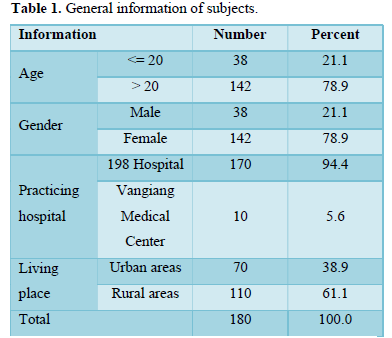

Students highly rated the satisfaction level of the clinical learning environment (3.24±0.29 points). In which, most students were satisfied with the faculty's leadership style (4.11±0.50 points) (Table 2).
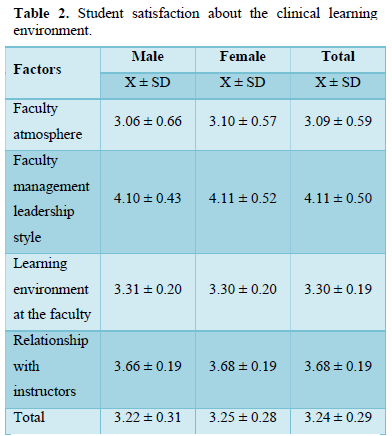

The results of the classification of student satisfaction by each factor show that the rate of being very satisfied with the atmosphere in the department is 10.6% and satisfied 81.7%, with 7.8% not satisfied. with this factor. The rate of being very satisfied with the leadership and management department is 71.9%; satisfaction with the learning environment at the faculty is 100% ' very satisfied with the relationship with the instructors 50.6% (Table 3).
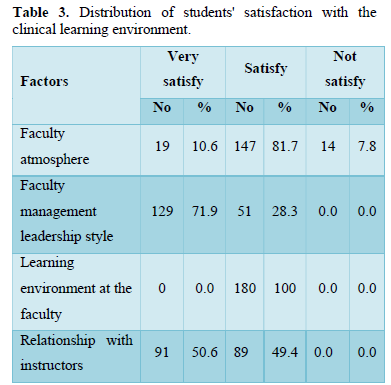

The results in the graph show that the very satisfied rate of students about the clinical learning environment is 5.6% (7.7% male students and 5.0% female students). There are 4.4% dissatisfied with the clinical learning environment (5.6% male students and 4.2% female students) (Table 4).
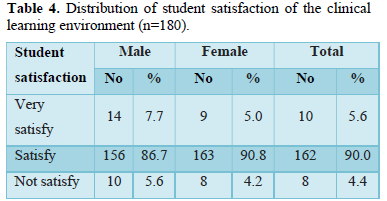

When assessing the correlation between the level of student satisfaction and the atmosphere at the internship faculty, the faculty's leadership style, the learning environment at the faculty, and the relationship with the instructors, the results show that there is a relationship between these factors. The positive correlation has statistically significant, in which the correlation between the atmosphere at the faculty and the satisfaction level of the students' clinical learning environment is the highest r-value (0,950) (Table 5).
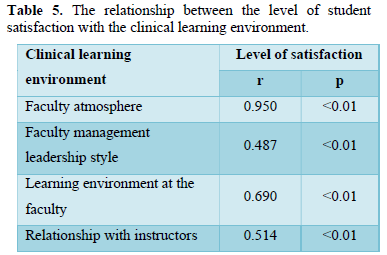

DISCUSSION
The clinical learning environment is an educational environment, a cradle and a mold for the formation of both ethical and talented medical staff. Clinical teaching often accounts for a large proportion of medical staff training programs in health-related universities and colleges. In a clinical learning environment, students will have to achieve three general goals: 1) Learn attitudes, behaviors, and manners, thereby training medical ethics and shaping the personality of medical staff. 2) Learn professional knowledge and skills, apply what they have learned to career development, and take care of people's health. 3) Practicing clinical thinking, learning the working style of medical staff, learning methodology, forming the ability to self-study, self-research and improve working capacity [2,6]. The study was conducted on 180 nursing students. Because the study subjects were full-time nursing students, female students were twice as many as male students, in which the proportion of male students accounted for 21.1% and the rate of female students was 78,9%. This is a common characteristic of nursing students. The majority of students intern at Hospital 198 (accounting for 94.4%), and 5.6% of students in research intern at Van Giang Medical Center. Regarding the place of residence of the subjects, the proportion of students from urban areas accounted for 38.9%, and from rural areas accounted for 61.1%. This ratio is consistent with the structure of the rural-urban population in Vietnam. The research students are in the age group of 19-25 years old with the mean age of 20.3±1.0 years old, the proportion of 20 years old or younger accounts for 78.9% and 21.1% are over 20 years old. This age group is suitable for the age of students and is similar to the study of Giang Nhan Tri Nghia and his colleagues: the age group is 21-22 years old [7,8]. The results of research on nursing education in Europe have emphasized that the relationship between staff and students is important for students to be able to achieve professional working practice [9-11]. In our study, the results of the classification of student satisfaction by each factor showed that the rate of very satisfied with the atmosphere in the faculty accounted for 10.6% and satisfied accounted for 81.7%, with 7 .8% are not satisfied with factor. The rate of being very satisfied with the management leadership style accounts for 71.9%. 100% of students are satisfied with the learning environment at the faculty and 50.6% of students are very satisfied with their relationship with instructors. Currently, the importance of clinical learning at the hospital in nursing education programs at universities and colleges is clearly understood, so they have paid attention to and improved the clinical learning environment [3,4]. In our study, it was found that the very satisfied rate of students about the clinical learning environment was 5.6% (specifically, 7.9% in male students and 4.9% in female students). There are 4.4% who are not satisfied with the clinical learning environment (specifically, 5.3% of male students and 4.2% of female students). The results of the report show that the clinical learning environment in the context of Vietnamese nursing education is not an optimal learning environment for nursing students [11,12]. To overcome these difficulties, it is necessary to strengthen cooperation and exchange between nursing schools and hospitals or clinical infrastructure that are chosen to become practice places for nursing students. Along with that, the records of student difficulties in the medical infrastructure should also be sent to clinical units through nursing education seminars so that appropriate remedial measures can be provided. Furthermore, nursing leaders, educators, and clinical counselors need to discuss specific learning goals and strategies, as well as change learning programs for nursing students in the community and in the current integration context. At the same time, there should be career orientation courses in the training program to help students understand this profession. Table 5 presents the correlation between student satisfaction and the atmosphere at the internship faculty, the faculty's leadership style, the learning environment at the faculty, the relationship with the instructors. The results found that there is a statistically significant positive correlation between the level of satisfaction and these factors. In which, the correlation between the atmosphere at the faculty and the satisfaction of students' clinical learning environment has the highest r-value (0,950). In Ho Thi Lan Vi's study, there was a positive correlation between student satisfaction, the atmosphere at the faculty of internships, the leadership style of the faculty, the nursing facilities at the faculty, the learning environment at the faculty, and relationships with instructors [13,14]. This result is similar to the study of d'Souza, M. S. and colleagues in 2015; Papastavrou, E. and colleagues (2016); Shabnum, H [15,17]. In this study, the relationship between the satisfaction level of students' clinical learning environment and the learning environment at the faculty had the highest r-value (0.864). According to the results of the study of Vo Thi Ngoc Ha and her colleagues: Clinical teaching activities influence on student satisfaction with clinical instructors, students who are taught directly and taught in groups more than 2 times have higher satisfaction than other groups, which is statistically significant with p
CONCLUSION
- The percentage of students who are very satisfied with the clinical learning environment is 5.6%, and 4.4% are not satisfied.
- The level of satisfaction with the clinical learning environment is high (3.24±0.29 points), in which most students are satisfied with the faculty’s management leadership style (4.11±0.50 points).
- There is a positive correlation (p<0.05) between the level of satisfaction and the atmosphere at the faculty, the learning environment at the faculty, the faculty's leadership style, and the relationship with the instructors.
- Alfes CM (2011) Evaluating the use of simulation with beginning nursing students. J of Nur Edu 50(2): 89-93.
- Nguyen VK, Nguyen TX (2011) Current status of clinical teaching for bachelor's degree in full-time nursing at Haiphong University of Medicine, Practical Medicine Megazine pp: 827-828.
- Thaibinh University of Medicine and Pharmacy (2010) Active teaching and student assessment in medical training, Medical Publishing House, Hanoi. Avalible online at: https://www.4icu.org/reviews/12240.htm
- Hanoi University of Medicine (2013) Lecture on communication skills for medical students, Medical Publishing House, Hanoi. Avalible online at: https://en.wikipedia.org/wiki/Hanoi_Medical_University
- Chan D (2002) Development of the clinical learning environment inventory: Using the theoretical framework of learning environment studies to assess nursing students’ perceptions of the hospital as a learning environment. J Nur Edu 41(2): 69-75.
- Thuc PV, Sang NN (2012) Clinical teaching methods, Medical Publishing House, Hanoi.
- Nghia GNT, Kieu GTM, Vu L (2019) Perceptions of nursing students about the clinical learning environment. Hochiminh City Med J 23(5): 113-119.
- Cope P, Cuthbertson P, Stoddart B (2000) Situated learning in the practice placement. J Adv Nur 31(4): 850-856.
- Dale B, Leland A, Dale JG (2013) What factors facilitate good learning experiences in clinical studies in nursing: bachelor students’ perceptions. ISRN Nursing 16 (5): 628-679.
- Vi HTL, Bich DTN, Thao PT (2020) Survey on satisfaction with the clinical learning environment of nursing students at Duy Tan University, J Sci Tech of Duy Tan Uni 4(41): 128-136.
- Loannav KT, Papathanasiou (2014) Views and Perceptions of Nursing Students on Their Clinical Learning Environment: Teaching and Learning. Nurse Education Today 34(1): 57-60.
- Masoumi FS (2005) A Qualitative Study of Nursing Student Experiences of Clinical Practice. BMC Nursing.
- Do Thi Nhu Y (2013) Evaluation of the satisfaction of medical students about the clinical practice environment, Master thesis, Hochiminh City University of Medicine and Pharmacy.
- MD Evridiki Papastavrou (2016) Nursing Students' Satisfaction of the Clinical Learning Environment. BMC Nursing.
- Papastavrou E, Dimitriadou M, Tsangari H, Andreou C (2016) Nursing students’ satisfaction of the clinical learning environment: a research study. BMC nursing 15 (1): 44.
- Papastavrou E, Lambrinou E, Tsangari H, Saarikoski M, Leino K (2010) Student nurses experience of learning in the clinical environment. Nurse Education in Practice 10 (3): 176-182. technology in Africa 23(1): 189-192.
- Ha VTN, Trang LT, Chau DT, Le TTT (2021) The relationship between teaching activities and satisfaction of nursing students with clinical instructors. J Nur Sci 4(2): 118-124.
- Jones LT. Judith L, Isabel H, Margaret M (2009) Staff-student relationships and their impact on nursing students’ belongingness and learning. J Adv Nur 65(2): 316-324.
QUICK LINKS
- SUBMIT MANUSCRIPT
- RECOMMEND THE JOURNAL
-
SUBSCRIBE FOR ALERTS
RELATED JOURNALS
- Advance Research on Alzheimers and Parkinsons Disease
- Journal of Oral Health and Dentistry (ISSN: 2638-499X)
- Journal of Ageing and Restorative Medicine (ISSN:2637-7403)
- Journal of Neurosurgery Imaging and Techniques (ISSN:2473-1943)
- International Journal of Radiography Imaging & Radiation Therapy (ISSN:2642-0392)
- International Journal of Diabetes (ISSN: 2644-3031)
- Journal of Allergy Research (ISSN:2642-326X)

